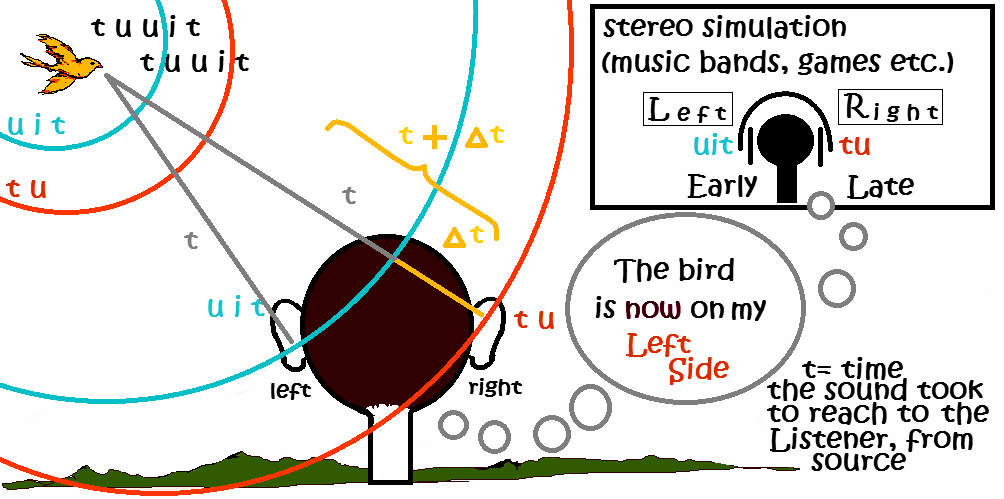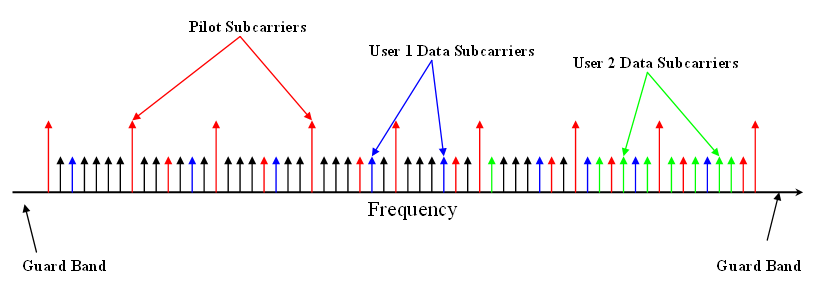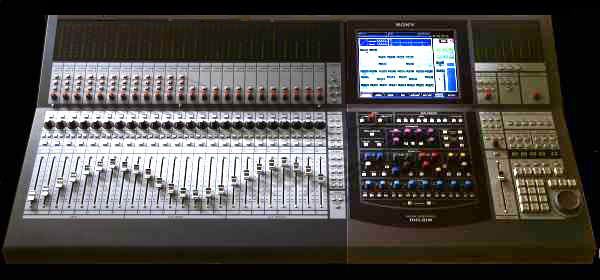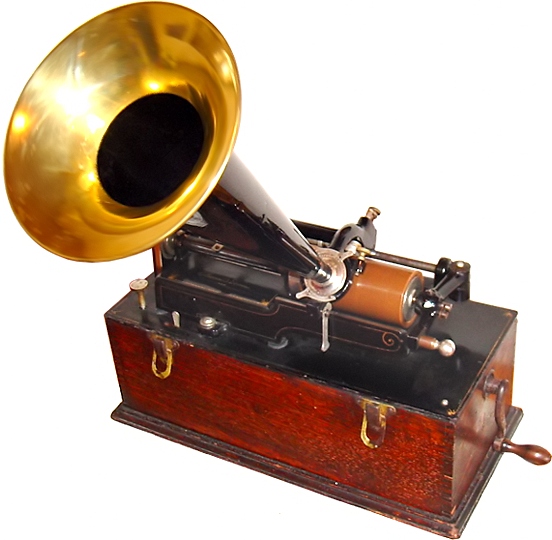|
Monophonic
Monaural sound or monophonic sound (often shortened to mono) is sound intended to be heard as if it were emanating from one position. This contrasts with stereophonic sound or ''stereo'', which uses two separate audio channels to reproduce sound from two microphones on the right and left side, which is reproduced with two separate loudspeakers to give a sense of the direction of sound sources. In mono, only one loudspeaker is necessary, but, when played through multiple loudspeakers or headphones, identical audio signals are fed to each speaker, resulting in the perception of one-channel sound "imaging" in one sonic space between the speakers (provided that the speakers are set up in a proper symmetrical critical-listening placement). Monaural recordings, like stereo ones, typically use multiple microphones fed into multiple channels on a recording console, but each channel is " panned" to the center. In the final stage, the various center-panned signal paths are usually mixed ... [...More Info...] [...Related Items...] OR: [Wikipedia] [Google] [Baidu] |
Stereophonic Sound
Stereophonic sound, commonly shortened to stereo, is a method of sound reproduction that recreates a multi-directional, 3-dimensional audible perspective. This is usually achieved by using two independent audio channels through a configuration of two loudspeakers (or stereo headphones) in such a way as to create the impression of sound heard from various directions, as in natural hearing. Because the multi-dimensional perspective is the crucial aspect, the term ''stereophonic'' also applies to systems with more than two channels or speakers such as quadraphonic and surround sound. Binaural recording, Binaural sound systems are also ''stereophonic''. Stereo sound has been in common use since the 1970s in entertainment media such as broadcast radio, recorded music, television, video cameras, cinema, computer audio, and the Internet. Etymology The word ''stereophonic'' derives from the Greek language, Greek (''stereós'', "firm, solid") + (''phōnḗ'', "sound, tone, voice" ... [...More Info...] [...Related Items...] OR: [Wikipedia] [Google] [Baidu] |
Sound Recording And Reproduction
Sound recording and reproduction is the electrical, Mechanical system, mechanical, electronic, or digital inscription and re-creation of sound waves, such as spoken voice, singing, instrumental music, or sound effects. The two main classes of sound recording technology are analog recording and digital recording. Acoustic analog recording is achieved by a microphone diaphragm that senses changes in atmospheric pressure caused by acoustics, acoustic sound waves and records them as a mechanical representation of the sound waves on a medium such as a phonograph record (in which a stylus cuts grooves on a record). In magnetic tape recording, the sound waves vibrate the microphone diaphragm and are converted into a varying electric current, which is then converted to a varying magnetic field by an electromagnet, which makes a representation of the sound as magnetized areas on a plastic tape with a magnetic coating on it. Analog sound reproduction is the reverse process, with a large ... [...More Info...] [...Related Items...] OR: [Wikipedia] [Google] [Baidu] |
FM Broadcasting
FM broadcasting is a method of radio broadcasting that uses frequency modulation (FM) of the radio broadcast carrier wave. Invented in 1933 by American engineer Edwin Armstrong, wide-band FM is used worldwide to transmit high fidelity, high-fidelity sound over broadcast radio. FM broadcasting offers higher fidelity—more accurate reproduction of the original program sound—than other broadcasting techniques, such as AM broadcasting. It is also less susceptible to Electromagnetic interference, common forms of interference, having less static and popping sounds than are often heard on AM. Therefore, FM is used for most broadcasts of music and general audio (in the audio spectrum). FM radio stations use the very high frequency range of radio frequency, radio frequencies. Broadcast bands Throughout the world, the FM broadcast band falls within the VHF part of the radio spectrum. Usually 87.5 to 108.0 MHz is used, or some portion of it, with few exceptions: * In the Commo ... [...More Info...] [...Related Items...] OR: [Wikipedia] [Google] [Baidu] |
Subcarrier
A subcarrier is a sideband of a radio frequency carrier wave, which is modulated to send additional information. Examples include the provision of colour in a black and white television system or the provision of stereo in a monophonic radio broadcast. There is no physical difference between a carrier and a subcarrier; the "sub" implies that it has been derived from a carrier, which has been amplitude modulated by a steady signal and has a constant frequency relation to it. FM stereo Stereo broadcasting is made possible by using a subcarrier on FM radio stations, which takes the left channel and "subtracts" the right channel from it — essentially by hooking up the right-channel wires backward (reversing polarity) and then joining left and reversed-right. The result is modulated with suppressed carrier AM, more correctly called sum and difference modulation or SDM, at 38 kHz in the FM signal, which is joined at 2% modulation with the mono left+right audio (which ... [...More Info...] [...Related Items...] OR: [Wikipedia] [Google] [Baidu] |
Loudspeaker
A loudspeaker (commonly referred to as a speaker or, more fully, a speaker system) is a combination of one or more speaker drivers, an enclosure, and electrical connections (possibly including a crossover network). The speaker driver is an electroacoustic transducer that converts an electrical audio signal into a corresponding sound. The driver is a linear motor connected to a diaphragm, which transmits the motor's movement to produce sound by moving air. An audio signal, typically originating from a microphone, recording, or radio broadcast, is electronically amplified to a power level sufficient to drive the motor, reproducing the sound corresponding to the original unamplified signal. This process functions as the inverse of a microphone. In fact, the ''dynamic speaker'' driver—the most common type—shares the same basic configuration as a dynamic microphone, which operates in reverse as a generator. The dynamic speaker was invented in 1925 by Edward W. Kellogg ... [...More Info...] [...Related Items...] OR: [Wikipedia] [Google] [Baidu] |
Audio Mixing (recorded Music)
In sound recording and reproduction, audio mixing is the process of optimizing and combining multitrack recordings into a final mono, stereo or surround sound product. In the process of combining the separate tracks, their relative levels are adjusted and balanced and various processes such as equalization and compression are commonly applied to individual tracks, groups of tracks, and the overall mix. In stereo and surround sound mixing, the placement of the tracks within the stereo (or surround) field are adjusted and balanced. Audio mixing techniques and approaches vary widely and have a significant influence on the final product. Audio mixing techniques largely depend on music genres and the quality of sound recordings involved. The process is generally carried out by a mixing engineer, though sometimes the record producer or recording artist may assist. After mixing, a mastering engineer prepares the final product for production. Audio mixing may be performed on a ... [...More Info...] [...Related Items...] OR: [Wikipedia] [Google] [Baidu] |
Phonograph Cylinder
Phonograph cylinders (also referred to as Edison cylinders after its creator Thomas Edison) are the earliest commercial medium for Sound recording and reproduction, recording and reproducing sound. Commonly known simply as "records" in their heyday (c. 1896–1916), a name which has been passed on to Phonograph record, their disc-shaped successor, these hollow cylinder, cylindrical objects have an audio recording engraved on the outside surface which can be reproduced when they are played on a mechanical cylinder phonograph. The first cylinders were wrapped with tin foil but the improved version made of wax was created a decade later, after which they were commercialized. In the 1910s, the competing disc record system Format war, triumphed in the marketplace to become the dominant commercial audio medium. Early development In December 1877, Thomas Edison and his team invented the phonograph using a thin sheet of tin foil wrapped around a hand-cranked, grooved metal cylinder. Tin f ... [...More Info...] [...Related Items...] OR: [Wikipedia] [Google] [Baidu] |
Revolutions Per Minute
Revolutions per minute (abbreviated rpm, RPM, rev/min, r/min, or r⋅min−1) is a unit of rotational speed (or rotational frequency) for rotating machines. One revolution per minute is equivalent to hertz. Standards ISO 80000-3:2019 defines a physical quantity called ''rotation'' (or ''number of revolutions''), dimensionless, whose instantaneous rate of change is called ''rotational frequency'' (or ''rate of rotation''), with units of reciprocal seconds (s−1). A related but distinct quantity for describing rotation is ''angular frequency'' (or ''angular speed'', the magnitude of angular velocity), for which the SI unit is the radian per second (rad/s). Although they have the same dimensions (reciprocal time) and base unit (s−1), the hertz (Hz) and radians per second (rad/s) are special names used to express two different but proportional ISQ quantities: frequency and angular frequency, respectively. The conversions between a frequency and an angular frequency ... [...More Info...] [...Related Items...] OR: [Wikipedia] [Google] [Baidu] |
AM Broadcasting
AM broadcasting is radio broadcasting using amplitude modulation (AM) transmissions. It was the first method developed for making audio radio transmissions, and is still used worldwide, primarily for medium wave (also known as "AM band") transmissions, but also on the longwave and shortwave radio bands. The earliest experimental AM transmissions began in the early 1900s. However, widespread AM broadcasting was not established until the 1920s, following the development of vacuum tube receivers and transmitters. AM radio remained the dominant method of broadcasting for the next 30 years, a period called the " Golden Age of Radio", until television broadcasting became widespread in the 1950s and received much of the programming previously carried by radio. Later, AM radio's audiences declined greatly due to competition from FM (frequency modulation) radio, Digital Audio Broadcasting (DAB), satellite radio, HD (digital) radio, Internet radio, music streaming services, and podca ... [...More Info...] [...Related Items...] OR: [Wikipedia] [Google] [Baidu] |
1 0 Channels (mono) Label
1 (one, unit, unity) is a number, numeral, and glyph. It is the first and smallest positive integer of the infinite sequence of natural numbers. This fundamental property has led to its unique uses in other fields, ranging from science to sports, where it commonly denotes the first, leading, or top thing in a group. 1 is the unit of counting or measurement, a determiner for singular nouns, and a gender-neutral pronoun. Historically, the representation of 1 evolved from ancient Sumerian and Babylonian symbols to the modern Arabic numeral. In mathematics, 1 is the multiplicative identity, meaning that any number multiplied by 1 equals the same number. 1 is by convention not considered a prime number. In digital technology, 1 represents the "on" state in binary code, the foundation of computing. Philosophically, 1 symbolizes the ultimate reality or source of existence in various traditions. In mathematics The number 1 is the first natural number after 0. Each natural numbe ... [...More Info...] [...Related Items...] OR: [Wikipedia] [Google] [Baidu] |
Background Music
Background music (British English: piped music) is a mode of musical performance in which the music is not intended to be a primary focus of potential listeners, but its content, character, and volume level are deliberately chosen to affect behavioral and emotional responses in humans such as concentration, relaxation, distraction, and excitement. Listeners are uniquely subject to background music with no control over its volume and content. The range of responses created are of great variety, and even opposite, depending on numerous factors such as, setting, culture, audience, and even time of day. Background music is commonly played where there is no audience at all, such as empty hallways, restrooms and fitting rooms. It is also used in artificial space, such as music played while on hold during a telephone call, and virtual space, as in the ambient sounds or thematic music in video games. It is typically played at low volumes from multiple small speakers distributing the musi ... [...More Info...] [...Related Items...] OR: [Wikipedia] [Google] [Baidu] |
Phonograph
A phonograph, later called a gramophone, and since the 1940s a record player, or more recently a turntable, is a device for the mechanical and analogue reproduction of sound. The sound vibration Waveform, waveforms are recorded as corresponding physical deviations of a helical or spiral groove engraved, etched, incised, or impressed into the surface of a rotating cylinder or disc, called a ''Phonograph record, record''. To recreate the sound, the surface is similarly rotated while a playback #Stylus, stylus traces the groove and is therefore vibrated by it, faintly reproducing the recorded sound. In early acoustic phonographs, the stylus vibrated a Diaphragm (acoustics), diaphragm that produced sound waves coupled to the open air through a flaring Horn loudspeaker, horn, or directly to the listener's ears through stethoscope-type earphones. The phonograph was invented in 1877 by Thomas Edison; its use would rise the following year. Alexander Graham Bell's Volta Laboratory an ... [...More Info...] [...Related Items...] OR: [Wikipedia] [Google] [Baidu] |








